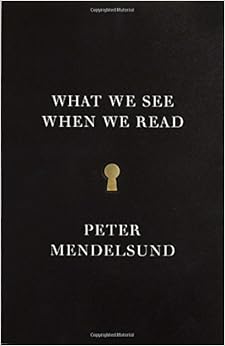
Finished reading What We See When We Read by Peter Mendelsund this morning. I have been reading both it and Wiman’s The Bright Abyss for a while. Satisfying to get them both read.

The back flyleaf says that Mendelsund is “associate art director of Alfred A. Knopf and a recovering classical pianist.”

I spotted this book while Christmas shopping in a bookstore last year. I made a note and managed to get a copy from the library. Mendelsund has created an intriguing mix of prose and design about his subject which is stated in the title.

Mendelsund wanders through many books that he is obviously very familiar with, examining what is going on in our heads when we read Anna Karenina or Through the Lighthouse and others.
He gets a lot right and it is interesting to read his clear insights that are on the brink of consciousness of readers, but that we are too busy doing to reflect on that often.

Again I find myself typing in interesting stuff from my stickies.
In the last chapter, Mendelsund gives a beautiful synopsis. It is so clear that I am putting the whole thing here if you would like to read it.
When we apprehend the world (the parts of it that are legible to us), we do so one piece at a time. These single pieces of the world are our conscious perceptions.What these conscious perceptions consist of, we don’t know, though we assume that our experience ofthe world is an admixture of that which is already present, and that which we ourselves contribute (our selves—our memories, opinions, proclivities, and so on).
“Authors are curators of experience. They filter the world’s noise, and out of that noise they make the purest signal they can—out of disorder they create narrative. They administer this narrative in the form of a book, and preside, in some ineffable way, over the reading experience. Yet no matter how pure the data set that authors provide to readers—no matter how diligently prefiltered and tightly reconstructed—readers’ brains will continue in their prescribed assignment: to analyze, screen, and sort. Our brain will treat a book as if it were any other of the world’s many unfiltered, encrypted signals. That is, the author’s book, for readers, reverts to a species of noise. We take in as much of the author’s world as we can, and mix this material with our own in the alembic of our reading minds, combining them to alchemize something unique. I would propose that this why reading ‘works’: reading mirrors the procedure by which we acquaint ourselves with the world. It is not that our narratives necessarily tell us something true about the world (though they might), but rather that the practice of reading feels like, and is like, consciousness itself: imperfect; partial; hazy; co-creative.

I snapped this pic with my phone last night as Rev Jen announced to the parish that we are purchasing a new pipe organ to be built by Martin Pasi. I immediately threw it up on Facebooger even as we were sitting in the room.
Pasi will begin building later this year. Installation is set for Fall 2016. I can’t believe this. I have been filled with disbelief throughout the entire process. Now I just hope I live long enough to enjoy playing this instrument for a while.
I have been dipping deeper into organ literature and spending careful rehearsal time with Bach and Vierne. It’s not conscious but I know my motivation to play beautiful music on my shitty present instrument has to be influenced by the fact that there are better instruments and one is soon coming to the place I work.